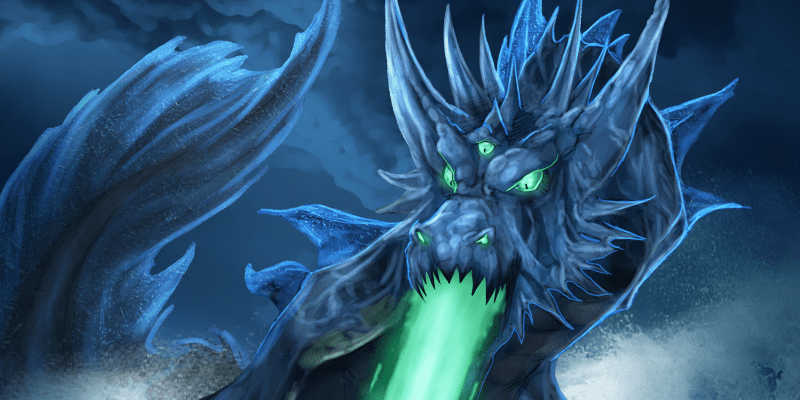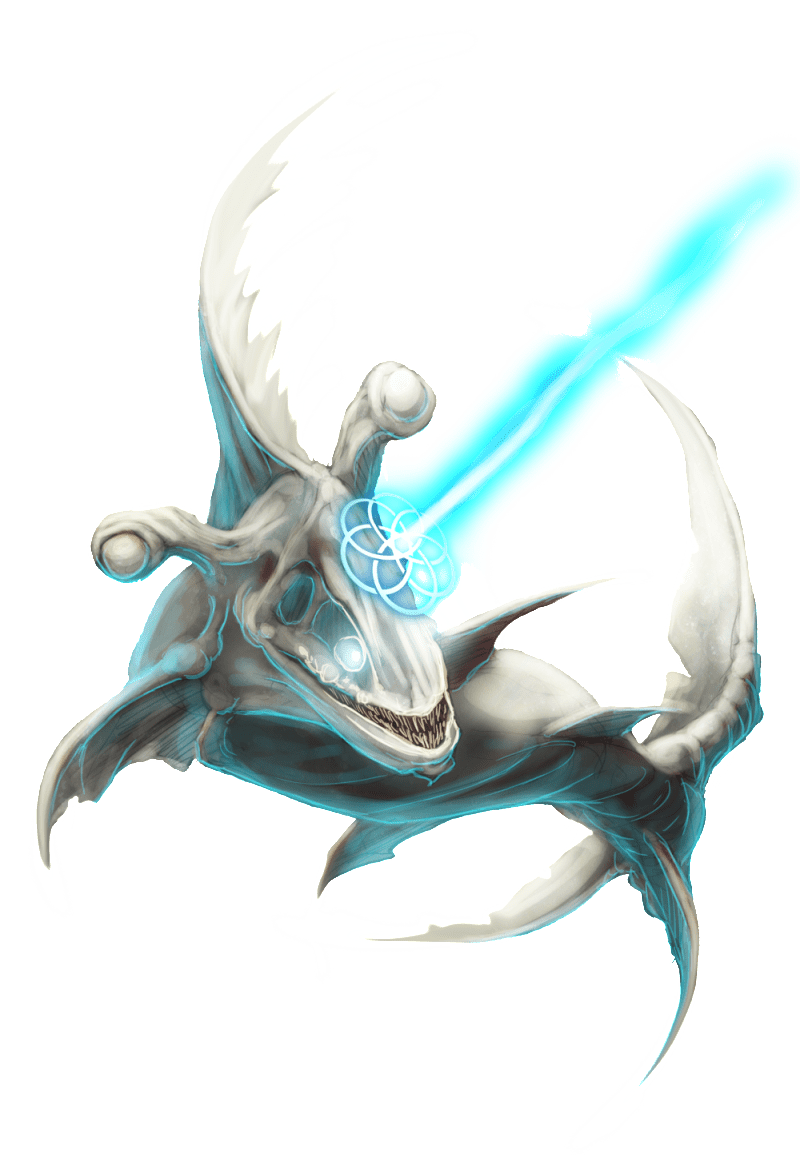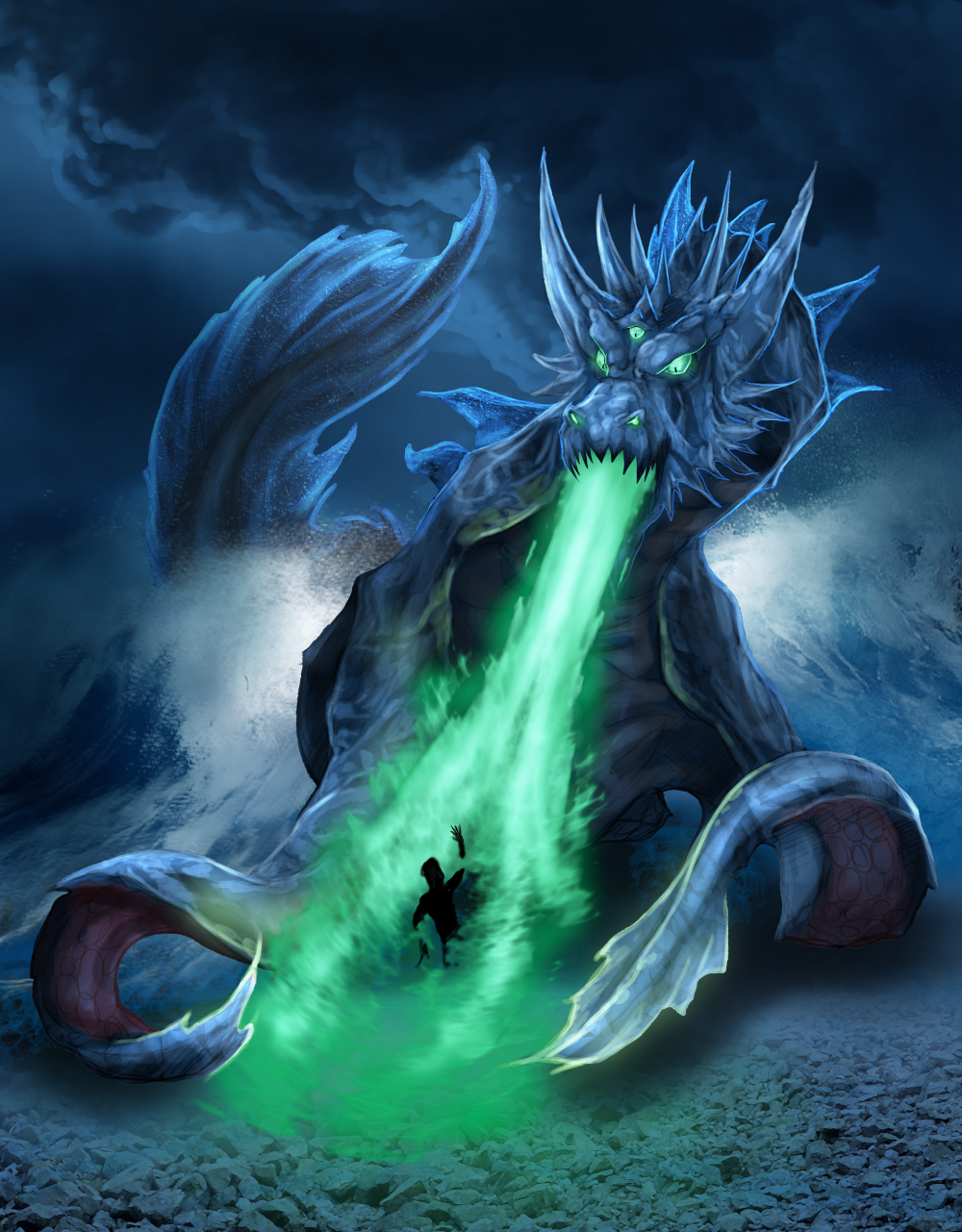25 Aquatic Enemies for 11th-15th Level Characters

In this series I will be presenting creatures you can use for villains, lieutenants, minions, and wild encounters for 5th edition aquatic games. I will also be presenting encounter seeds for these villains at each tier. This week I bring you enemies and encounters for parties of 10th through 15th level characters.
Though these monster lists and story seeds are inspired by 5th edition, they can be used as adventure ideas for any fantasy RPG.
Many of these creatures have been listed in my lower-tiers of play articles and make excellent lieutenants and minions for higher levels of play. Since there are very few creatures from the 5th edition Monster Manual that are easily adaptable to higher levels of aquatic play, I have the honor to present two new aboleth-related creatures from Rogue Genius Games‘ excellent “Horrors of the Aboleth” supplement for Pathfinder. For this tier of play, the livyathan (CR 19) and the slime golem (CR 8) provide both a draconic beast and a mindless but powerful minion to your game.
Rogue Genius has also been kind enough to grant permission for two lower-level creatures to be converted as well, including the cetacean-born skum (CR 3), and the protoaboleth (CR 3). Both of these creatures will be added to the 1st-5th level enemies post soon.
But these four variants of my favorite aquatic villains are just the beginning. “Horrors of the Aboleth” includes aboleth-inspired monsters from Challenge Rating 3 to 17, including the behemoth (CR 16), engulfer (CR 8), manipulator (CR 10), muculent husk (CR 11), and the larval aboleth swarm (CR 6), plus twisted items, feats, and spells for use in your Pathfinder games. Or use the themes I introduce in these conversions to bring them into your 5th edition games yourself!
The protoaboleth, cetacean skum, livyathan, and the slime golem were created by aquatic-monster master, Sam Hing, with aberrant artwork by Bob Greyvenstein. Conversions and artwork used with permission.
Make sure to check out Shawn Ellsworth’s overview of 10 Awesome Monsters for Aquatic Encounters, as well as his articles for other terrains right here on Tribality.
Villains
For the purposes of this series, villains are defined as individuals that act as either instigators of complex local, city-wide, or country-wide plots, or creatures that can act as the main antagonist for one or more adventures. I’ve typically limited Villains to creatures with a minimum of 10 Intelligence. This led me to some surprising discoveries. For example, I didn’t realize that several low-level undead creatures have impressive Intelligence scores, including banshees, ghosts, ghasts, revenants, wraiths, and even will-o’-wisps!
I’ve also included a few surface creatures that make excellent villains and can be easily adapted to an aquatic campaign (such as the mind flayers and yuan-ti), as well as one or more new villains for you to use against your party.
Bonus Villain: CR 19 aboleth livyathan
Lieutenants
Lieutenants act as the higher-level minions of villains. They are smart enough to instigate plots of their own, typically at the behest of their villainous masters. Alternately, lieutenants may act as Villains for the lowest level parties at each tier. For example, a young black dragon (CR 7) can act as a main villain for a party of 6th level PCs, as long as it has enough minions and an interesting enough lair to make the encounter enjoyable.
Minions/Pets
Minions are the lowest-tier servants of the villains and lieutenants, or beasts that can be used as wandering monsters, guards, or random encounters. Lieutenants (and even Villains) of lower-level parties can easily be the Minions of higher-level Villains. This category also includes creatures with Intelligence scores below 10, including beasts, constructs, plants, and undead that can be used to flesh out encounters.
Keep in mind that large numbers of lower CR creatures can also make for interesting encounters. For example, sharks make great encounters in small numbers, but some species of sharks, including the hammerhead (use stats for hunter shark) swim in shoals of hundreds and even thousands! Though a combat using 100 hunter sharks might appear tedious, it can be a terrifying experience and a challenge for any party. At 45 hit points and 13 damage per bite, even these CR 2 creatures can deal significant damage to 11th level or higher PCs, especially after a party member gets damaged and triggers the shark’s blood frenzy.
Since the Lieutenants (and even Villains) of lower-tiers can be used as Minions in higher-level encounters, there is plenty of material to use. I have, however, included one or more new creatures you can use against your players when inspiration has hit.
Bonus Minion: the CR 8 slime golem
Encounters
In the accompanying article for each tier, I will provide general plot outlines and story seeds for you to use to create encounters for your aquatic games. I will include options for campaigns focused entirely on aquatic races as well as for surface campaigns looking to shake things up.
For 10th-15th level encounter seeds, check out our upcoming Encounters posts.
11th-15th Level
Villains
Challenge Rating 12
- Archmage (can be of any aquatic race or creature capable of having an Intelligence of 18 or higher; increase CR by 1 if already greater than 12)
Challenge Rating 13
- Storm Giant
Challenge Rating 14
- Black Dragon (Adult)
Challenge Rating 15
- Green Dragon (Adult)
Challenge Rating 17
- Dracolich
Challenge Rating 19
- Livyathan (Aboleth)
Lieutenants
Challenge Rating 7
- Yuan-Ti Abomination (add the Amphibious or Water Breathing traits)
- Black Dragon (Young)
Challenge Rating 8
- Assassin (any aquatic race or creature with Intelligence 12 or higher; increase CR by 1 if already greater than 8)
- Green Dragon (Young)
- Spirit Naga
Challenge Rating 11
- Marid
Challenge Rating 12
- Archmage (can be of any aquatic race or creature capable of having an Intelligence of 18 or higher; increase CR by 1 if already greater than 12)
Minions/Pets
Challenge Rating 3
- Green Hag
Challenge Rating 4
- Ghost
Challenge Rating 5
- Revenant
- Wraith
Challenge Rating 7
- Black Dragon (Young)
- Mind Flayer (CR 7; add Amphibious or Water Breathing traits)
- Yuan-Ti Abomination (CR 7; add the Amphibious or Water Breathing traits)
Challenge Rating 8
- Assassin (any aquatic race or creature with Intelligence 12 or higher; increase CR by 1 if already greater than 8)
- Green Dragon (Young)
- Half-dragon Veteran (black/green) (CR 5; add Amphibious trait)
- Hydra
- Slime Golem (Aboleth)
Slime Golem
This creatures appears to be a massive fish comprised of milky slime. It is utterly featureless until it grows a pair of thick pseudopods.
Large construct, unaligned
Armor Class 15 (natural armor)
Hit Points 85 (10d10+30)
Speed 20 ft., swim 30ft.
Initiative +4 (or +6 if using the alternate Initiative rules)
_______
STR 23 (+6) DEX 18 (+4) CON 17 (+3) INT 4 (-3) WIS 17 (+3) CHA 1 (-5)
_______
Damage Resistances bludgeoning, piercing, slashing from non-magical weapons
Damage Immunities poison
Condition Immunities blinded, charmed, deafened, exhaustion, frightened, paralyzed, petrified, poisoned
Senses blindsight 120 ft., passive Perception 13
Languages –
Challenge 8
_______
Construct. The slime golem does not need to breath, eat, drink, or sleep.
Immutable Form. The slime golem is immune to any spell or efec that would alter its form.
Magic Resistance. The slime golem has advantage on saving throws against spells and other magical effects.
Magic Weapons. The slime golem’s tentacle and slime ball attacks are considered magical.
Telepathic Control. Any aboleth that contributed slime to a slime golem’s creation may control the creature at a range of up to a mile. The aboleth sees through the golem’s senses, and may use any of the golem’s abilities. The aboleth may use its spell-like abilities through the golem, though attacks are made at disadvantage and saving throws against the aboleth’s spells are made at advantage. If two aboleth vie for control of a slime golem, they must make opposed Charisma checks, with the winner controlling the golem until challenged. There is a cumulative 5% chance per round of such telepathic combat that the golem breaks free of all control and attacks the nearest living targets for 1 minute. If no creature is near enough to move to and attack, the golem attacks an object, with preference for an object smaller than itself. A slime golem is immune to any attempts at telepathic control while in this berserk state.
Transformation. A slime golem can change its shape as an action, taking on the form of a Large ooze, a Medium sized fish-like shape, or transforming into a featureless bipedal or piscinoid humanoid of either Medium or Large size. While in these forms, the slime golem retains all of its abilities. When in ooze form, the slime golem may squeeze through spaces as if it were a Small creature.
ACTIONS
Multiattack. The slime golem makes 2 tentacle attacks, 2 slime ball attacks when it takes the attack action.
Tentacle. Melee Weapon Attack: +10 to hit, reach 5ft., one target. Hit: 10 (1d6 + 6) bludgeoning damage. If the target is a creature, it must succeed on a DC 15 Constitution saving throw or become diseased. The disease has no effect for 1 minute and can be removed by any magic that cures disease. After 1 minute, the diseased creature’s skin becomes translucent and slimy, the creature can’t regain hit points unless it is underwater, and the disease can be removed only by heal or another disease-curing spell of 6th level or higher. When the creature is outside a body of water, it takes 6 (1d12) acid damage every 10 minutes unless moisture is applied to the skin before 10 minutes have passed.
Slime Ball. Ranged Weapon Attack: +9 to hit, range 60 ft., one target. Hit: Target gains the grappled condition for 1 minute. To escape the grapple, the target must succeed on a DC 15 Strength (Athletics) or Dexterity (Acrobatics) check. If the target is a creature, it must succeed on a DC 15 Constitution saving throw or become diseased. The disease has no effect for 1 minute and can be removed by any magic that cures disease. After 1 minute, the diseased creature’s skin becomes translucent and slimy, the creature can’t regain hit points unless it is underwater, and the disease can be removed only by heal or another disease-curing spell of 6th level or higher. When the creature is outside a body of water, it takes 6 (1d12) acid damage every 10 minutes unless moisture is applied to the skin before 10 minutes have passed. The slime ball’s range is unaffected while underwater.
Immersion. A slime golem may use an action to attempt a grapple against a creature of Large size or smaller. If successful, the slime golem pulls its victim into its own form. The immersed creature gains the restrained condition and must make a DC 15 Constitution save at the end of each of its rounds as if hit by the slime golem’s tentacle. In addition, the target must make a DC 15 Constitution save at the end of each if its rounds or gain the ability to breath water (and only water) for 3 hours. Renewed contact with an aboleth’s mucus cloud or subsequently being re-immersed into a slime golem and failing another save extends the effect for another 3 hours. A slime golem may only hold a single target within itself at a time, and may choose to eject a victim on their round as a bonus action. To escape being immersed, the target must succeed on a DC 15 Strength (Athletics) or Dexterity (Acrobatics) check.
Livyathan
A towering draconic form breaks the water’s surface with a bubbling roar. Its head possesses the jaws and spiky horns of a dragon and the three eyes of an aboleth. Its front limbs are great tentacles, and it lacks rear limbs, its body ending in a tentacle-like tail.
Huge dragon, Neutral evil
Armor Class 19 (natural armor)
Hit Points 265 (20d12+120)
Speed 40 ft., swim 80ft., fly 80ft.
Initiative -1 (or +9 if using the alternate Initiative rules)
_______
STR 27 (+8) DEX 8 (-1) CON 23 (+6) INT 20 (+5) WIS 17 (+3) CHA 22 (+6)
_______
Saving Throws Dex +5 Con +12 Wis +9
Skills Arcane +11 Perception +9
Damage Resistances bludgeoning, piercing, slashing from non-magical weapons
Damage Immunities cold, poison
Condition Immunities frightened, paralyzed, petrified, poisoned
Senses darkvision 120 ft., passive Perception 19
Languages Aboleth, Common, Deep Speech, Draconic, Primordial
Challenge 19
_______
Legendary Resistance (3/day). If the livyathan fails a saving throw, it can choose to succeed instead.
Magic Resistance. The livyathan has advantage on saving throws against spells and other magical effects.
ACTIONS
Multiattack. The livyathan can use its horror. It then makes three attacks: one with its bite and two with its tentacles.
Bite. Melee Weapon Attack: +14 to hit, reach 10ft., one target. Hit: 19 (2d10+8) piercing damage, plus 7 (2d6) acid damage.
Tentacle. Melee Weapon Attack: +14 to hit, reach 15ft., one target. Hit: 15 (2d6 + 8) bludgeoning damage. If the target is a creature, it must succeed on a DC 20 Constitution saving throw or become diseased. The disease has no effect for 1 minute and can be removed by any magic that cures disease. After 1 minute, the diseased creature’s skin becomes translucent and slimy, the creature can’t regain hit points unless it is underwater, and the disease can be removed only by heal or another disease-curing spell of 6th level or higher. When the creature is outside a body of water, it takes 6 (1d12) acid damage every 10 minutes unless moisture is applied to the skin before 10 minutes have passed.
Tail. Melee Weapon Attack: +14 to hit, reach 15ft., one target. Hit: 17 (2d8 + 8) bludgeoning damage. In addition, the target becomes grappled. If the target is a creature, it must succeed on a DC 20 Constitution saving throw or become diseased. The disease has no effect for 1 minute and can be removed by any magic that cures disease. After 1 minute, the diseased creature’s skin becomes translucent and slimy, the creature can’t regain hit points unless it is underwater, and the disease can be removed only by heal or another disease-curing spell of 6th level or higher. When the creature is outside a body of water, it takes 6 (1d12) acid damage every 10 minutes unless moisture is applied to the skin before 10 minutes have passed.
Horror. Each creature of the livyathan’s choice that is within 120 feet of the livyathan and aware of it must succeed on a DC 20 Wisdom saving throw or become frightened for 1 minute. A creature can repeat the saving throw at the end of each of its turns, ending the effect on itself on a success. If a creature’s saving throw is successful or the effect ends for it, the creature is immune to the livyathan’s Horror for the next 24 hours.
Acid Slime Breath (Recharge 6). The livyathan exhales a cone of acidic slime that coats all foes in a 60-foot cone that fail a DC 20 Dexterity save. Foes that fail the save take 63 (18d6) acid damage, or half as much on a successful save. All creatures caught within the cone must also make a DC 20 Constitution save or gain the ability to breath only water (not air) for 3 hours. In addition, if the breath weapon is used under water or targets foes within water, the slime separates into droplets on the following round, forming into an acidic jellyfish swarm (see below).
Enslave (3/Day). The livyathan targets one creature it can see within 30 feet of it. The target must succeed on a DC 20 Wisdom saving throw or be magically charmed by the livyathan until the livyathan dies or until it is on a different plane of existence from the target. The charmed target is under the livyathan’s control and can’t take reactions, and the livyathan and the target can communicate telepathically with each other over any distance.
Whenever the charmed target takes damage, the target can repeat the saving throw. On a success, the effect ends . No more than once every 24 hours, the target can also repeat the saving throw when it is at least 1 mile away from the livyathan.
LEGENDARY ACTIONS
The livyathan can take 3 legendary actions, choosing from the options below. Only one legendary action option can be used at a time and only at the end of another creature’s turn. The livyathan regains spent legendary actions at the start of its turn.
Detect. The livyathan makes a Wisdom (Perception) check.
Tail Attack. The livyathan makes a tail attack.
Wing Attack (Costs 2 Actions). The livyathan beats its wings. Each creature within 10 feet of the livyathan must succeed on a DC 20 Dexterity saving throw or take 15 (2d6 + 8) bludgeoning damage and be knocked prone. The livyathan can then fly up to half its flying speed.
LAIR ACTIONS
On initiative count 20 (losing initiative ties), the livyathan takes a lair action to cause one of the following effects; the dragon can’t use the same effect two rounds in a row:
- Superheated water and dissolved chemicals erupts from a point on the ground the livyathan can see within 120 feet of it, creating a 20-foot-high, 5-foot-radius hydrothermal vent plume (or geyser if on the surface). Each creature in the plume’s area must make a DC 20 Dexterity saving throw, taking 21 (6d6) fire damage on a failed save, or half as much damage on a successful one.
- A shockwave shakes the lair in a 60-foot radius around the livyathan sending powerful currents throughout the area. Each creature other than the livyathan in that area must succeed on a DC 20 Dexterity saving throw or be knocked prone (if underwater, creatures become disoriented, with the same game effects as being knocked prone).
- Hydrothermal gases form a cloud in a 20-foot-radius sphere centered on a point the livyathan can see within 120 feet of it. The sphere spreads around corners, and its area is lightly obscured. It lasts until initiative count 20 on the next round. Each creature that starts its turn in the cloud must succeed on a DC 20 Constitution saving throw or be poisoned for 1 minute. The creature may repeat the saving throw at the end of each of its turns to negate the effect.
REGIONAL EFFECTS
The region containing an livyathan’s lair is warped by the creature’s presence, which creates one or more of the following effects:
- Underground surfaces within 1 mile of the livyathan’s lair are slimy and wet and are difficult terrain.
- Water sources within 1 mile of the lair are supernaturally fouled. Enemies of the livyathan that drink such water vomit it within minutes.
- Deep sea fissures and hydrothermal vent fields appear within 1 mile of the livyathan’s lair.
If the livyathan dies, these effects fade over the course of 3d10 days.
Swarm of Acid Jellyfish
Large swarm of tiny beasts
Armor Class 14 (natural)
Hit Points 40 (8d8)
Speed 20’; climb 20’; swim 20’
Initiative +1
_______
Str 6 (-2) Dex 14 (+2) Con 10 (+0) Int 1 (-5) Wis 7 (-2) Cha 1 (-5)
_______
Damage Resistances bludgeoning, piercing, slashing
Condition Immunities charmed, frightened, paralyzed, petrified, prone, restrained, stunned
Skills Perception +0
Senses Blindsight 10 ft., Passive Perception 8
Languages –
Challenge 3 (700xp)
_______
Water Breathing. The acid jellyfish swarm can breath water.
Swarm. The swarm fills a 10 foot by 10 foot square, can occupy another creature’s space and vice versa, and the swarm can move through any opening large enough for a Tiny beast. The swarm can’t regain hit points or gain temporary hit points.
_______
Actions
Tentacles. +5 to hit, reach 0 feet, all targets in the swarm’s space, 10 (4d4) acid damage and the targets must make a DC 10 Constitution save. On a failed save, the target is overwhelmed by painful stingers, becoming poisoned for 1 minute. The target may repeat the save at the end of each of its turns to end the condition.





